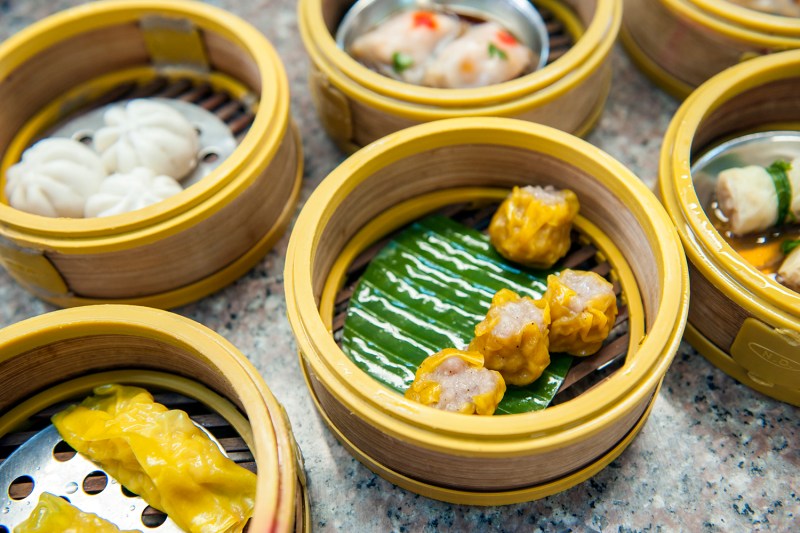
One of the most famous culinary traditions of China, dim sum restaurants are a culinary institution in many American Chinatowns. Translated in Cantonese as “to touch the heart,” dim sum is usually eaten in the morning and is originally from Southern China. Throughout China, there are different versions of dim sum, called xiao chi (“little eats” in Mandarin) besides the Cantonese version. For this guide, Cantonese dim sum will be the focus.
Although delicious, dim sum can be an intimidating process because of its seemingly endless array of dumplings and pastries. However, we’d say that dim sum is a great experience and a lively environment for a social gathering.
What’s the difference between dim sum and dumplings?
First, let’s clarify this. Below, we refer to dim sum as dumplings, but there is a difference between dim sum and general dumplings; however, the two are related. Here are some key differences to know.
Dim sum is a complete Cantonese dining experience featuring a variety of small, steamed or fried dishes served in steamer baskets or on small plates. It’s meant to be shared among friends and family and is typically enjoyed with tea (mentioned below). Dim sum includse dumplings, but it also can involve other dishes like rice noodle rolls, buns, and vegetables.
Dumplings is a broader term for a food item consisting of a dough or pastry wrapper filled with savory or sweet ingredients. They can be steamed, boiled, fried, or pan-fried. Dumplings come in many varieties around the world, and can be a part of dim sum cuisine, but also enjoyed on their own or in other meals.
Here’s an analogy: Think of dim sum like a tapas spread – a collection of small plates meant for sharing. Dumplings would be one of the possible dishes you might find on that tapas spread.
How to order dim sum

Many dim sum restaurants, especially older ones, are centered on push carts laden with various steamed dumplings and dishes, all placed in bamboo or metal steamers. These carts are pushed around the restaurant by different attendants, allowing diners to order directly from them. This can be an intimidating experience for non-Chinese speakers or diners unfamiliar with dim sum items.
A good ordering strategy is to observe what other tables are ordering and select the same items from the carts. Cart attendants will also voluntarily showcase their items to diners and it’s perfectly polite to point and order. Finally, hot tea is an important part of the dim sum experience, and most restaurants will include tea as part of the meal.
Nowadays, many dim sum restaurants don’t feature carts, opting instead for small paper menus where diners can check off what they want. Remember, most dim sum dishes are small, usually featuring three to four dumplings per order.
8 essential dim sum items
Most dim sum restaurants feature a long list of items that can be quite challenging to a novice. Some of these will be specialty items but almost every dim sum restaurant will also feature these eight classic dishes.
Har gow (shrimp dumpling)

A classic item that will grace almost every dim sum table, these semi-translucent shrimp dumplings feature plump shrimp encased in soft tapioca flour wrappers. These dumplings might appear simple but are quite sophisticated in their construction. Har gow are delicious by themselves or dipped in a bit of chili oil. Many dim sum restaurants will also have similar dumplings featuring shrimp with pea shoots.
Siu mai (steamed dumpling)

A classic Chinese surf and turf combination of diced pork and shrimp, siu mai are meatier in flavor than har gow. Some siu mai can also contain mushrooms and water chestnuts, while others are topped with crab roe.
Chicken feet

Chicken feet (called “phoenix talons” in Chinese) can seem like a complicated eating endeavor at first glance. The Chinese palate holds great value in the offcuts often deemed inedible by Western palates. This chicken feet dish is first fried and then steamed in a sweet, slightly spicy sauce. There’s no meat, instead, the appeal is the soft texture of skin and tendon, all packed with an intense chicken flavor.
Char siu bao (barbecue pork bun)

Probably the most accessible item taste-wise for the Western palate, char siu bao can be either steamed or baked and sometimes topped with a crumbly, sugary crust. The filling is a red, sugary-sweet chopped mixture of Cantonese-style barbecue pork.
Black beans pork ribs
Besides dumplings, dim sum also features many meat dishes. This popular item contains small pork rib pieces steamed with garlic, preserved black beans, and chilies. The meat is tender but does not fall off the bone, still maintaining a pleasantly meaty chew.
Cheung fun (steamed rice roll)

These white, soft rice noodles are filled with a variety of items, including shrimp, barbecue pork or beef. The texture of cheung fun is soft and slippery, a great contrast to the different savory fillings. Cheung fun is usually served with a sweet soy sauce poured over the top.
Loh mai gai (steamed glutinous rice)

Wrapped in a lotus leaf, this bundle of steamed glutinous rice is laced with diced chicken or pork, sweet Chinese sausage, and mushrooms. Glutinous rice has a natural sweetness that tastes different from other types of rice. Some restaurants will also add salted duck eggs or dried shrimp. Finally, it’s important to remember that this item is more filling than other dim sum dishes, so order accordingly.
Egg tarts

One of the best parts of dim sum is that desserts are served alongside the savory items. One of the most popular sweet pastries is the egg tart. There are two main types of egg tarts in dim sum: Cantonese or Macanese/Portuguese. Both versions feature a flaky crust holding a sweet, egg-forward custard. The Portuguese egg tarts are less “eggy,” more custard-like, and dotted brown on top from scorched sugar.
Chef Ming Tsai’s favorite dim sum “The Bing”

(By Chef Ming Tsai of Blue Ginger, Blue Dragon and Simply Ming)
Chef Tsai has re-created a classic — the Bing. These are most similar to jianbing, which is found on the streets of Taipei, Taiwan, and they are similar to a folded crepe dumpling. This recipe is a quick home version and uses lumpia (Filipino food spring roll) wrappers.
Ingredients
For the bing
- 1 pound shiitakes, sliced
- 1 tablespoon garlic, minced
- 1 tablespoon ginger, minced
- 1 red onion, small dice
- 1 cup peeled edamame
- 1/4 cup pepitas, toasted
- 1 tablespoon soy sauce
- 1/2 pound watercress, washed, spun dry, and chopped up small (save some for plating)
- Kosher salt and freshly ground black pepper to taste
- Grapeseed oil to cook
- 1 package lumpia (Menlo brand) wrappers
For the dipping sauce
- 1/4 cup tamari
- 1/4 cup rice wine vinegar
- 1-2 tablespoons Sambal (or your favorite hot sauce)
- 1/2 bunch scallion greens, thinly sliced
Method
- In a wok, coat with oil. Add and stir shiitakes until soft and season with salt and pepper.
- Add the garlic, ginger, and red onions and saute for 2-3 minutes. Add the edamame, pepitas, and soy sauce. Transfer to a sheet tray and let cool.
- In a large bowl, toss the mix with watercress. Taste for seasoning and adjust. It should be a little salty, as the wrapper has no flavor.
- Gently wet all sides and place about 2-3 tablespoons of the mix in the middle of the wrapper. Fold all four corners in (like a baseball diamond, folding home plate up, then bringing in first base, then third, and finally, second base to meet the rest of the corners at the top. Place the seam side down. Repeat with the remaining filling and wrappers.
- In a saute pan, pan sear on the folded side first for about 4-6 minutes until golden brown, then flip and cook until the remaining side also reaches a golden color.
- Mix the sauce ingredients until it’s well combined. Set it aside or in the refrigerator or until you are ready to use.



